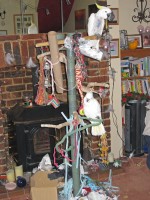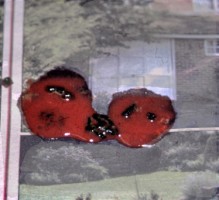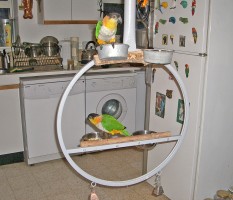Poisons and Toxins
Poisons and Toxins: Protecting Your Birds From Danger
by Gary Gallerstein D.V.M.
(Adapted From The Complete Bird Owner's Handbook)
(AKJ 2018 - an older article, and one we have published before, but still with relevance today)
Keeping birds in our home environment presents us with many challenges. Ensuring the safety and well-being of our feathered friends is a large responsibility and one that is taken seriously by many of those that enjoy keeping birds as pets. Keep in mind that our homes are not a natural environment for birds and in many ways can be very hostile to them. To keep them from harm one should always monitor their birds when they are out of their cages.

Two cockatoos on a play stand, amidst a variety of household hazards - electric wiring, candles, log burning stove, etc
The following excerpts are from The Complete Bird Owner's Handbook, Gary A. Gallerstein D.V.M., Howell Book House, 1994. This excellent book covers all aspects of bird care and health that is essential for both the pet bird owner and avian professional. We wish to thank the author for the permission to present this material to you. Net Pets hopes that you will find Dr. Gallerstein's information as an exceptional reference source in helping to provide a safe environment for your birds.
Poisoning
Route of Poisoning
- Ingestion (by mouth)
- Inhalation (by breathing)
- Topical (Contact with skin)
Suspect poisoning if your bird is sick and you observe:
- Contact with a known poisonous substance, including chewing or playing with the packaging, exposure to fumes or odours.
- Opened or spilled containers of any poisonous substance.
- Toxic plants recently chewed on.
- A foreign substance noted on the feathers.
Signs To Watch
- For Sudden onset of regurgitation, diarrhoea, coughing, breathing problems, and/or depression.
- Bloody droppings, Redness or burns around the mouth.
- Convulsions.
- Paralysis.
- Shock.
First Aid For Poisoning
1. Remove the poison to prevent further ingestion.
2. For eye contact, flush the eye with lukewarm water. For skin contact, flush the area with water. For fume intoxication, ventilate the room immediately - open windows, use a fan, or better yet, remove the bird from the area altogether.
3. Call your veterinarian.
- Bring a sample of the poison and its packaging.
- Bring a sample of the bird's most recent droppings.
- Provide general supportive care.
Lead Poisoning
Lead poisoning is one of the most common toxicities occurring in pet birds. There are a number of potential sources of lead in most homes. This type of poisoning could frequently be prevented by simply recognizing the common sources of lead in the environment.
Sources Of Lead For Pet Birds
Bird toys weighted with lead, old costume jewelry, lead caulking in stained-glass windows, fishing weights, curtain weights, and some types of screens and wires cause the majority of lead poisoning in pet birds.
Newsprint, lead pencils, and paint manufactured within the last twenty years will not cause poisoning.
As strange as it may seem, inspect branches to be used as perches before placing them in the cage. There have been cases of birds finding and ingesting buckshot embedded in the wood.
Signs To Watch For
- Depression, weakness.
- Blindness
- Seizures, "walking in circles," "head wandering".
- Regurgitation.
- Droppings; excessively wet, may even be bloody ("tomato juice-colored" urine)
- General signs of a sick bird.

Fresh blood in droppings, resulting from heavy-metal poisoning - lead or zinc (AKJ)
First Aid For Lead Poisoning:
Unfortunately, there is no first aid available. In most instances, the pet owner is not even aware the bird has ingested lead. Treatment is very specific, and veterinary care must be initiated as soon as possible.
"Teflon Toxicity" or Polymer Fume Fever.
Polytetrafluoroethylene (PTFE) is a synthetic polymer used as a non-stick surface in cookware. The brand names Teflon, Silverstone, and T-Fal are the best known, but PTFE-coated products are also manufactured under other trade names.
As Dr. Peter Sakas states: Under normal cooking conditions, PTFE-coated cookware is stable and safe. When PTFE is heated above 530 degrees Farenheit, however, it undergoes breakdown and emits caustic (acid) fumes. Most foods cook at lower temperatures: water boils at 212 degrees, eggs fry at 350 degrees, and deep frying occurs at 410 degrees. But when empty PTFE-coated cookware is left on a burner set on the high setting, it can reach temperatures of 750 degrees or greater. Thus, if a pan is being pre-heated on a burner and forgotten, or if water boils out of a pot, breakdown of the PTFE can occur. In other words, PTFE cookware has to be "abused" to emit toxic fumes, but this is not as rare as it might seem; many people fall asleep after they put pots or pans on the stove to heat.
Birds kept in areas close to the kitchen will usually die very shortly after breathing the fumes. Even birds kept in another room are at great risk. Severe breathing difficulties, such as gasping for breath, may be seen just prior to death. Humans, dogs, cats, and other mammals are somewhat less sensitive to the very serious effects of these fumes.

Pair of Black-headed Caiques in a kitchen environment - high-risk area for birds! (AKJ)
First Aid For Teflon Toxicity
1. Remove the affected bird immediately from the home and supply lots of fresh air. Unfortunately, other than this, no first aid exists.
2. Call your avian veterinarian immediately.
Insecticide Poisoning
The most common insecticide poisoning in pet birds occurs when the house is sprayed ("fogged" or "bombed") for various pests. As already mentioned, birds have very sensitive respiratory systems. Always take the birds and their cages out of the house before spraying. When spraying is finished, open all doors and windows to help remove the odours. Use fans if needed. Do not bring your birds back in the home for at least twenty-four hours. Consult your veterinarian for the safest and most effective foggers.
First Aid For Insecticide Poisoning
1. Remove the bird immediately and supply lots of fresh air.
2. Provide general supportive care.
3. Call your veterinarian immediately.
4. Bring the insecticide along.
(Author's Note: Our homes "house" many dangerous products. There's a very real risk for pets getting into them. For birds, the kitchen poses the greatest peril. Gallerstein, The complete Bird Owner's Handbook, Howell Book House, 1994)
Common Household Poisons
Acetone, Ammonia, Antifreeze, Ant syrup or paste, Arsenic, Bathroom bowl cleaner, Bleach, Boric acid, Camphophenique, Carbon tetrachloride, Charcoal lighter, Clinitest tablets, Copper and brass cleaners, Corn and wart remover, Crayons, Deodorants, Detergents, Disinfectants, Drain cleaners, Epoxy glue, Fabric softeners, Garbage toxins, Garden sprays, Gasoline, Gun cleaner, Gunpowder, Hair dyes, Herbicides, Hexachlorophene (in some soaps), Indelible markers, Insecticides, Iodine, Kerosene, Lighter fluid, Linoleum (contains lead salts), Matches, Model glue, Mothballs, Muriatic acid, Mushrooms (some varieties, Nail Polish, Nail polish remove, Oven cleaner, Paint, Paint remover, Paint thinner, Perfume, Permanent wave solutions, Pesticides, Photographic solutions, Pine oil Plants, Prescription and non-prescription drugs, Red squill, Rodenticides, Rubbing alcohol, Shaving lotion, Silver polish, Snail bait, Spot remover, Spray starch, Strychnine, Sulphuric acid, Suntan lotion, Super glue, Turpentine, Weed killers, Window cleaners.
(Source: Adapted from Gary Gallerstein, Bird Owner's Home Health and Care Handbook (New York: Howell Book House, 1984); Sheldon Gerstenfeld, The Bird Care Book (Reading, Mass.: Addison-Wesley, 1981); and Margaret L. Petrak, ed., Diseases of Cage and Aviary Birds, 2nd ed. Philadelphia, Lea and Febiger, 1982 )
Common Poisonous Substances
Acids, Alkalis, Petroleum Products, Dishwasher detergent, Drain cleaner, Floor polish, Furniture polish, Gasoline, Kerosene, Paint remover, Paint thinner, Shoe polish, Toilet bowl cleaner, Wax (floor or furniture), Wood preservative.
(Source:Sheldon Gerstenfeld, The Bird Care Book (Reading, Mass.: Addison-Wesley, 1981)
Plants Considered Toxic to Birds
(The following is a list of some potentially toxic plants. Be sure you correctly identified all plants in your bird's environment.When using these lists, ensure you use the Scientific Name to identify Plants, if uncertain remove the plant )
(Abbreviations: Spp=subspecies, Sp=species)
| Plant Name | Scientific Name | Parts Known to be Poisonous |
|---|---|---|
| Acokanthera | Acokanthera spp. | all parts toxic |
| Amaryllis | Amaryllidaceae | Bulbs |
| American Yew | Taxus canadensis | Needles, seeds |
| Angel's Trumpet | Datura spp., | leaves, seeds, flowers |
| Apricot | Prunus armeniaca, | pits, leaves, and bark |
| * Autumn Crocus | Colchicum autumnalle | bulb |
| Avocado | Persea americana | pit, leaves, unripe fruit, and stems |
| Azalea | Rhododendron occidentale | Leaves |
| Balsam pear | Memordica charantia | Seeds, outer rind of fruit |
| Baneberry | Actaia spp. | Berries, roots |
| Belladonna | Atropa belladonna | All parts |
| Bird of Paradise | Caesalpina gilliesii | Seeds |
| Bittersweet | Celastrus spp. | All parts |
| Black Locust | Robinia pseudoacacia | Bark, sprouts, foliage |
| * Bleeding Heart | Dicentra | all parts |
| Bluegreen algae | Schizophycaea spp | Some forms toxic |
| Bracken Fern | Pteridium aquilinum | All parts |
| Some forms toxic Boxwood | Buxus sempervirens | Leaves, stems |
| Buckthorn | Rhamnus spp. | Fruit, bark |
| Burdock | Arctium spp. | All parts |
| Buttercup | Ranunculus spp. | Sap, bulbs |
| Calla lily | Zantedeschia aethiopica | Leaves |
| Caladium | Caladium spp. | Leaves and rhizome |
| Castor Oil Plant | Ricinus communis | Beans, leaves |
| Catclaw Acacia | Acacia greggii, | twigs and leaves |
| Chalice vine | Solandra spp. | All parts |
| Cherry tree | Prunus spp. | Bark, twigs, leaves, pits |
| Chinaberry | Melia azadarach | All parts |
| Chokecherry | Birdcherry Prunus | seeds (stones), |
| Christmas candle | Pedilanthus tithymaloides | Sap |
| Clematis | Clematis spp. | All parts |
| Coral plant | Jatropha multifida | Seeds |
| Cowslip | Caltha polustris | Seeds |
| Crocus (autumn) | Cholchicum autumnale | All parts |
| Cycad, or Sago Cycas | Cycas revoluta | All parts |
| Daffodil | Narcissus spp | Bulbs |
| Daphne | Daphne spp. | Berries |
| Datura | Datura spp. | Berries |
| Deadly amanita | Amanita muscaria | All parts |
| Death camas | Zygadenis elegans | All parts |
| Delphinium | Delphinium spp. | All parts |
| Devil's Ivy | Epipremnum aureum | All parts |
| Dieffenbachia | Dieffenbachia picta | Leaves |
| Eggplant | Solanaceae spp. | All parts but fruit |
| Elderberry | Sambucus mexicana, | roots, leaves, stems, bark |
| Elephant's ear (taro) | Colocasis spp. | Leaves, stem |
| English ivy | Ilex aquafolium | Berries, leaves |
| English yew | Taxus baccata | needles, seeds |
| Euonymus | Euonymus spp. | fruit, bark, leaves |
| European Pennroyal | Mentha pulegium | |
| False henbane | Veratrum woodii | All parts |
| Figs | Ficus spp | sap |
| Fly agaric mushroom (deadly amanita) | Amanita muscaria | All parts |
| Four o'clock | Mirabilis jalapa | All parts |
| Foxglove | Digitalis purpurea | Leaves, seeds |
| Golden chain (laburnum) | Laburnum anagyroides | All parts, especially seeds |
| Heliotrope | Heliotropium spp., | leaves |
| Hemlock | poison Conium spp. | All parts, especially roots and seeds |
| Hemlock | water Conium spp. | All parts especially roots and seeds |
| Henbane | Hyocyanamus niger | Seeds |
| Holly | Ilex spp. | Berries |
| Horse chestnut | Aesculus spp. | Nuts, twigs |
| Horse Nettle | Solanum carolinense | All parts |
| Hyacinth | Hyacinthinus orientalis | Bulbs |
| Hydrangea | Hydrangea spp. | Flower,bud |
| Indian turnip (jackinthepulpit) | Arisaema triphyllum | All parts |
| Iris (blue flag) | Iris spp. | Bulbs |
| Ivy (Boston, English, and some others) | Hedera spp. | All parts |
| Japanese yew | Taxus cuspidata | Needles, seeds |
| Java bean (lima bean) | Phaseolus lunatus | Uncooked beans |
| Jerusalem cherry | Solanum pseudocapsicum | Berries |
| Jessamine, Yellow | Gelsemium sempervirens, | leaves, stems |
| Jonquil | Narcissus jonquilla | All parts |
| Jimsonweed (thornapple) | Datura spp. | Leaves, seeds |
| Juniper | Juniperus virginiana | Needles, stems, berries |
| Lantana | Lantana spp. | Immature berries |
| Larkspur | Delphinium spp. | All parts |
| Laurel Kalmia, Ledum | Rhododendron spp. | All parts |
| Lilly of the valley | Convallaria majalis | All parts, including the water in which they have been kept |
| Lobelia | Lobelia spp. | All parts |
| Locoweed | Astragalu mollissimus | All parts |
| Lords and ladies (cuckoopint) | arum sp. | All parts |
| Lupine | Lupinus spp. | All parts |
| Marijuana | Cannabis sativa | Leaves |
| Mayapple | Podophyllum spp. | All parts, except fruit |
| Mescal bean | Sophora spp. | Seeds |
| Mistletoe | Santalales spp. | Berries |
| Milkweed | Asclepias spp. | All parts |
| Mock orange | Poncirus spp. | Fruit |
| Monkshood | Aconitum spp. | Leaves, roots |
| Moonseed | Menispermum canadense | All parts |
| Morning glory | Ipomoea spp. | All parts |
| Mushrooms | Amanita spp. and many others | All parts |
| Narcissus | Narcissus spp. | Bulbs |
| Nightshades (all types) | Solanum spp. | Berries, leaves |
| Oak | Quercus | acorn, young plant |
| Oleander | Nerium oleander | Leaves, branches, nectar of blossoms |
| Pennyroyal | Mentha pulegium | All parts |
| Peach | Prunus persica, | leaves, pit, bark |
| Peony | Paeonia officinalis | All parts |
| Periwinkle | Vinca minor, Vinca rosea | All parts |
| Peyote | Lophophora williamsii | All parts |
| Philodendron | Philodendron spp. | Leaves, stems |
| Pigweed | Amaranthus spp. | All parts |
| Plum | Prunus spp., | leaves, pit, bark |
| Poison Hemlock | Conium maculatum | All parts |
| Poison ivy | Toxicodendron radicans | Sap |
| Poison oak | Toxicodendron quercifolium | Sap |
| Poison Sumac | Rhux vernix | All parts |
| Poinsettia | Euphorobia pulcherrima | Leaves, flowers |
| Pokeweed (inkberry) | Phytolacca americans | Leaves, roots, immature berries |
| Poppy | Papaver somniferum and related spp. | All parts |
| Potato | Solanum tuberosum | Eyes and new shoots |
| Pothos | Eprimemnun aureum | All parts |
| Primrose | Primula spp. | All parts |
| Privet | Lingustrum volgare | All parts, includling berries |
| Ragwort | Senecio jacobea and related spp. | All parts |
| Red Maple | Acer rubrum | All parts |
| Rhododendron | Rhododendron spp. | All parts |
| Rhubarb | Rheum rhaponticum | Leaves |
| Rosary pea (Indian licorice) | Abrus precatorius | Seeds |
| Sage | Salvia officinalis | All parts |
| Sedum | Sedum | All parts |
| Shamrock Plant | Medicago lupulina, Trifolium repens, Oxalis acetosella | All parts |
| Skunk cabbage | Symplocarpus foetidus | All parts |
| Snowdrop | Ornithogalum umbellatum | All parts, especially buds |
| Snow on the mountain (ghostweed) | Euphorbia marginata | All parts |
| Sorrel | Rumex spp., Oxalis spp. | All parts |
| Spindle Tree | Euonymus | leaves, fruit, bark |
| Spurges | Euphorbia spp. | All parts |
| Star of Bethlehem | Ornithogalum umbellatum | All parts |
| Sweet pea | Lathryus latifolius | Seeds and fruit |
| Tansy | Tanacetum vulgare | all parts |
| Tobacco | Nicotinia spp. | Leaves |
| Tomato | Lycopersicon esculentum | stems and leaves |
| Tulip | Tulipa spp. | All parts |
| Vetches | Vicia spp. | All parts |
| Virginia creeper | Pathenocissu quinquefolia | Sap |
| Water Hemlock | Cicuta spp. | |
| Waxberry | Symphoricarpos albus | |
| Western yew | Taxus breviflora | Needles, seeds |
| Wisteria | Wisteria spp. | All parts |
| Yam bean | Pachyrhizus erosus | Roots, immature pods |
Source: Adapted from American Medical Association Handbook of Poisonous and Injurious Plants (Chicago: American Medical Association, 1985); R. Dean Axelson, Caring For Your Pet Bird (Poole-Dorset, England: Blanford Press, 1984) Gary Gallerstein, Bird Owner's Home Health and Care Handbook (New York: Howell Book House, 1984); Greg J. Harrison and Linda R. Harrison, eds., Clinical Avian Medicine and Surgery (Philadelphia: W.B. Saunders, 1986) and John M. Kingsbury, Poisonous Plants of the United States and Canada (Englewood Cliffs, N.J.:Prentice-Hall, 1964).Alicia McWatters, Ph.D., C.N.C.
A recently published booklet by Louise Jakobsen also lists some common plants safe to give to parrots and other birds, with the added advantage of some excellent illustrations. For more details visit - browse & flower ID
See also - Toxic Fumes
